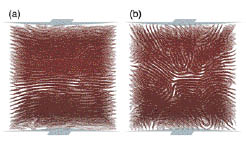Rolled Lamellar Structure of Surfactant Membranes Induced by Shear Flow
H. Shiba, H. Noguchi, and G. Gompper
Surfactant molecules in water self-assemble into various structures such as micelles and bilayer membranes, which display a rich variety of rheological properties. It is known that under shear flow, lamellar membranes can be oriented parallel or perpendicular to the shear-gradient direction. Surprisingly, under high shear flow, the membranes transform the planar lamellae to a closely-packed multi-lamellar vesicle structures, so-called the onion phase. The onion radius is reversible and can be described by a unique decreasing function of the shear rate. Although this onion phase was experimentally discovered 20 years ago, the formation mechanism is not understood so far. Since the onion size is in a micro meter scale, it is far beyond applicable length scales for molecular simulations. Thus, we employed a highly coarse-grained membrane model, a meshless-membrane model, in which a membrane particle represents not a lipid molecule but a patch of the bilayer membrane. The particles self-assemble into membranes via multibody potential interactions.

Fig. 1. Snapshot of surfactant membranes in simple shear flow. (a) A planar lamellae structure is formed at a low shear rate. (b) At a high shear rate, a rolled lamellar structure is formed perpendicularly to the flow direction. Top and bottom arrows represent the flow directions. The membranes are viewed from the flow direction.
At low shear rates, planar lamellae structures are formed at large membrane volume fractions (see Fig. 1a). At high shear rates, lamellar states exhibit undulation instability, leading to rolled or cylindrical membrane shapes oriented in the flow direction (see Fig. 1b). At even higher shear rate, the planar lamellae structures are formed again. The spatial symmetry and the structure factor of this rolled state agree with those of intermediate states during lamellar-to-onion transition measured by time-resolved small angle neutron and X-ray scattering experiments. A cylindrical or wavy lamellar structure was speculated to be this intermediate structure, but could not be distinguished from the scattering pattern alone. Our simulation results revealed that it is a rolled structure instead of regular cylindrical or wavy structures. The planar membranes become unstable in the flow gradient direction so that the membranes are rolled in perpendicular to the flow direction. We have not reproduced the onion structure itself. We will investigate the effects of defects and finite system size to pursue understanding of the onion phase.
References
- [1] H. Shiba, H. Noguchi, and G. Gompper, J. Chem. Phys. 139, 014702 (2013).
